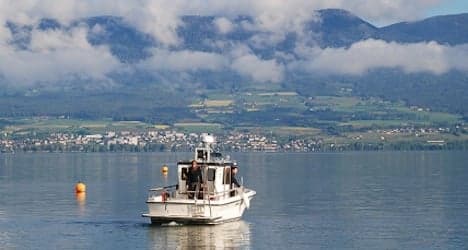Scientists find craters beneath Lake Neuchâtel

Scientists have discovered four large craters at the bottom of Lake Neuchâtel that rate among the largest of their kind in the world.
The “pockmarks” — one measuring 160 metres in diameter and ten metres deep — were identified by the Geological Institute of Zurich’s Federal Institute of Technology (ETH).
Anna Reusch, a doctoral student, is credited with first observing an “unusual shape” on an observation panel from an echo sounder during a routine patrol with a research vessel.
What she discovered was a perfectly round crater that is one of the biggest ever found in a freshwater lake.
Reusch immediately informed her professor, Michael Strasser, of the find.
“I’ll remember this day for a long time — I never expected anything like this,” she said, according to a recent news release from ETH.
“It just goes to show that even in the 21st century there are still thrilling and exciting discoveries to be made in Switzerland.”
Reusch was working with a team on the “Dynamite” project, sponsored by the Swiss National Science Foundation.
Her goal is to look for traces of past earthquakes in the sediments of lakes in the western Swiss Plateau, an area between the Jura Mountains and the Alps.
The team has located four craters all off the northwest shore of Lake Neuchâtel at a depth of 100 metres.
Scientists have nicknamed the largest one “Crazy Crater” because of its unusual characteristics.
They discovered that water is bubbling up from a fissure beneath the crater keeping sediments in suspension, ETH said.
“Reusch believes it is most likely that the craters are linked to the karst systems of the neighbouring Jura Mountains,” the institute said.
“Water there seeps underground, flows beneath the bed of Lake Neuchâtel and seeks out the path of least resistance up to the surface.”
The findings of the research have been published in Geophysical Research Letters, an academic journal.
Comments
See Also
The “pockmarks” — one measuring 160 metres in diameter and ten metres deep — were identified by the Geological Institute of Zurich’s Federal Institute of Technology (ETH).
Anna Reusch, a doctoral student, is credited with first observing an “unusual shape” on an observation panel from an echo sounder during a routine patrol with a research vessel.
What she discovered was a perfectly round crater that is one of the biggest ever found in a freshwater lake.
Reusch immediately informed her professor, Michael Strasser, of the find.
“I’ll remember this day for a long time — I never expected anything like this,” she said, according to a recent news release from ETH.
“It just goes to show that even in the 21st century there are still thrilling and exciting discoveries to be made in Switzerland.”
Reusch was working with a team on the “Dynamite” project, sponsored by the Swiss National Science Foundation.
Her goal is to look for traces of past earthquakes in the sediments of lakes in the western Swiss Plateau, an area between the Jura Mountains and the Alps.
The team has located four craters all off the northwest shore of Lake Neuchâtel at a depth of 100 metres.
Scientists have nicknamed the largest one “Crazy Crater” because of its unusual characteristics.
They discovered that water is bubbling up from a fissure beneath the crater keeping sediments in suspension, ETH said.
“Reusch believes it is most likely that the craters are linked to the karst systems of the neighbouring Jura Mountains,” the institute said.
“Water there seeps underground, flows beneath the bed of Lake Neuchâtel and seeks out the path of least resistance up to the surface.”
The findings of the research have been published in Geophysical Research Letters, an academic journal.
Join the conversation in our comments section below. Share your own views and experience and if you have a question or suggestion for our journalists then email us at [email protected].
Please keep comments civil, constructive and on topic – and make sure to read our terms of use before getting involved.
Please log in here to leave a comment.